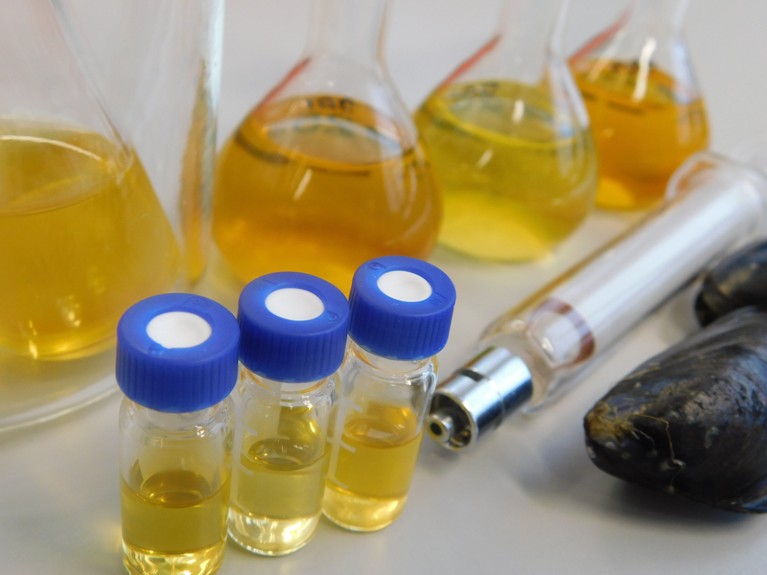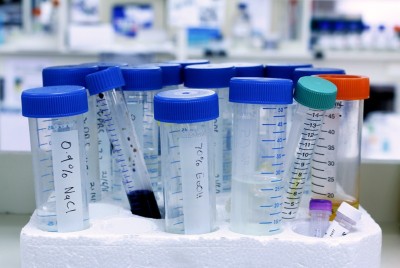
One lab’s choices to cut back on waste production and energy consumption — such as switching from plastic to reusable glassware — saved thousands of euros.Credit: Jane Kilcoyne
It started in 2019, with a simple switch from plastic 200-milliliter containers to compostable ones. But over the next year, Jane Kilcoyne, a research chemist, and her laboratory went on to save €15,800 (US$16,000), shrink their non-chemical waste by more than 95% and reduce their consumption of single-use plastics by 69%. The seven-person lab tests thousands of samples of shellfish for toxins every year at the Marine Institute, a government agency responsible for marine research, in Galway, Ireland.
In March 2022, they published a paper about how they reduced the environmental impacts of their lab1. By ordering and preparing solutions and reagents only as required and extending expiry dates of homemade solutions, they reduced their chemical waste by around 23%, or 300 litres. Finally, with a few small changes, such as keeping the fume-hood sash down while the device is not in use and raising the temperature of their cold storage, they lowered the total electricity consumption of the institute’s entire 11,000-square-metre headquarters by 26%.
Although environmental sustainability is thought of as expensive, many strategies adopted by Kilcoyne and her colleagues involved using less — whether chemicals, paper, energy or plastic. The team’s savings dwarfed the small costs of their sustainability measures, such as buying a filter for their chemical storage cabinet and setting up a system to recycle their polystyrene.
What can you do to make your lab greener?
Kilcoyne spearheaded the first part of the project, which focused on reducing waste (a colleague then led the energy-reduction part). She talked to Nature about the initiative’s challenges and successes, how her team can be a blueprint for other labs and what she’d like to see governments and others do to help.
What does your lab do?
We run Ireland’s national monitoring programme for toxins in shellfish. We get just over 3,000 samples per year that need to be tested for regulated toxins, and we complete more than 5,000 tests per year. We also do a lot of research on biotoxins.
What were you able to achieve?
We were producing about 4,000 kilograms of waste per year, and we’ve got that down to 130 kilograms. Much of the reduction was achieved just by composting and recycling, and not using single-use plastics. It made a big difference.
When we looked at switching to glass instead of plastic, there were concerns about toxin carryover and contamination. In our paper, we demonstrated that carryover didn’t happen — I showed that using glass had no impact on the results of our shellfish toxin tests. Initially, there’s always going to be some pushback against any change, but once you can demonstrate that it doesn’t affect the results, then people are more open to it.
We use a company called Waste Matters, based in Clara, Ireland, for polystyrene recycling. We have a shed at the back of the lab, and once it is full of polystyrene boxes, Waste Matters uses a machine to take the air out of the polystyrene, which becomes ‘plastic logs’. Those are shipped abroad, mostly to mainland Europe, where various companies use them.
Did the results of any of the changes surprise you? Is there one change that saved a lot of money?
Using compostable containers for sample storage was not only an effective replacement for plastic containers, but also about twofold cheaper. We observed the biggest cost savings from reducing operating times of fume hoods and cutting our use of organic solvents in the lab.
How long did it take to implement the changes?
We started lowering our plastic consumption in 2019 by switching to reusable glassware and composable pots. It took about a year to get everything on the waste side implemented.
The energy side of things took longer. Energy efficiency was spearheaded by our institution’s facilities team and Toni Hollowell, the facilities manager at the institute and one of the co-authors of the paper. E-mails were constantly being sent out to staff across the building, reminding them to switch off equipment. It took the facilities team a long time to work out how we use our fume hoods and which ones could be turned off when.
We’re still looking for ways to improve our sustainability. All the team members are on board with it — they’ve seen the benefits. Everyone is so good now at turning off equipment and pulling down the fume-hood sashes. It’s just become normal and automatic.
The Irish government’s 2019 Climate Action Plan set a target to improve energy efficiency by 33% by 2020. Did that affect your lab’s plans at all?
The government mandates to reduce our waste and increase our energy efficiency helped. I think I would have tried to do it anyway. I had thought, “Surely there’s something we can be doing to be more sustainable.” But the government strategies and policies definitely emboldened me, and I think I got more support from management because of them. If that government policy hadn’t been there, it would have been more difficult because people really don’t like change. Particularly when we’re dealing with standard operating procedures (SOPs) — they’re very formal, and you have to follow them exactly. To change things, you have to rewrite the SOPs or amend them, and people just don’t like the extra work involved.
But the fact that we saw significant financial savings should encourage people to spearhead change.
What would you recommend to other labs that want to be more sustainable?
Being part of a network is great for spurring ideas and motivating change. In Ireland, there is a network (of which I am a member) called Irish Green Labs, There’s also the Sustainable European Laboratories network. The My Green Lab ambassador programme is open to everyone, offers training modules and hosts talks on lab sustainability.
Tell us more about My Green Lab certification.
The certification programme involves completing a survey and getting a certain score. It also requires certain changes be made to freezer inventories, water consumption and ventilation. We’ve started work on our freezer inventory, but we haven’t looked at other things, such as water consumption.
What sort of institutional change would you like to see?
I hope that there’s more government support for these kinds of changes and more changes in terms of how labs are funded. Funding agencies should mandate some form of green certification in a lab prior to it being funded. There are a lot of other requirements in terms of research — such as integrity, diversity and human resources. I think it’s also essential that labs operate sustainably. There’s a campaign under way by My Green Lab to push for science funders to stipulate greater lab sustainability as a requirement for funding. That would make a huge difference.

 Webcast: how to green your lab
Webcast: how to green your lab
 What can you do to make your lab greener?
What can you do to make your lab greener?
 Analysis: the biodiversity footprint of the University of Oxford
Analysis: the biodiversity footprint of the University of Oxford


